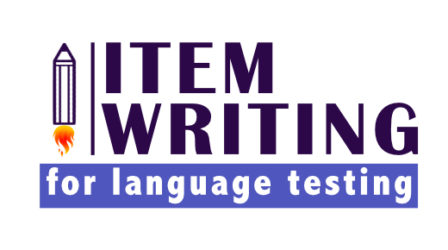Speaking tasks are used for direct testing of speaking ability, which means that test-takers are required to produce an extended (beyond individual words or short phrases) spoken response to a given stimulus.
Unlike direct testing, indirect testing of speaking ability attempts to assess competencies underlying speaking ability, such as the knowledge of grammar, pronunciation, or pragmatics. Although it is widely accepted that this knowledge plays an important role in one’s speaking ability, it can be argued that speaking ability goes beyond these individual ‘components’. This might mean that a test-taker who knows spoken grammar, can pronounce individual words well, etc. will not necessarily be able to take part in a discussion or give a talk. That is why, setting direct speaking tasks is the most common approach to assessing speaking ability nowadays.
There exist a wide variety of speaking tasks that can be used in a test. Below, some general recommendations for producing effective speaking tasks are given. Then, the most common types of speaking tasks are outlined and recommendations for producing tasks of each type are provided.
General recommendations for producing speaking tasks
- A good speaking task will elicit enough rateable language from test-takers (i.e., enough speech that the examiner can rate). This can be ensured by choosing topics that are appropriate for test-taker age, interest, and life experience; the topic should also be interesting enough to act as motivation for test-takers to speak.
- A speaking task should be unpredictable enough so that test-takers cannot rehearse their answers before the test. E.g., always asking test-takers to speak about simple topics such as ‘My home’, ‘My hobby’ should be avoided because these topics are predictable and will result in test-takers memorising the topics for the test.
- A good speaking task is goal-oriented, which means that test-takers should have a purpose in speaking other than simply producing enough language for assessment. The purpose should be reasonably authentic (i.e., people might speak for the given purpose in real-life situations). It should be remembered, though, that it is not possible to achieve full situational authenticity within a testing situation.
- A speaking task can include the following materials:
- Instructions for test-takers. Having clear and detailed instructions is particularly important for paired/group test formats. Typical speaking task instructions will specify what the test-takers have to do in the task, whether they need to use any additional materials, the designated time for talking, whether they have any preparation time and if so for how long, how they need to interact with the examiner and/or other test-takers.
- Task materials. If relevant, the materials necessary to perform the task such as pictures, charts, maps, tables, topic cards, role cards, etc. may be used. The materials should be clear, the language of the materials should be simpler than the level of the test, also, the materials should be of high printing quality (e.g., photos should be in colour and of high resolution). All materials should be trialled with several students who have a similar profile to the target test-taker population.
- Interlocutor script. In high-stakes testing, the interlocutor script is usually utilised to ensure comparability of test versions across different administrations and with different examiners. An interlocutor script normally includes the plan of interaction with the test-taker, the main prompts, additional questions, etc. The interlocutor script is not necessary for classroom testing situations, but it is still a good idea for the examiner to have a plan of the test.
Example of materials for a presentation speaking task:
Interlocutor script: Tell me about the best holiday you have ever had. You can use the questions on your topic card for ideas. Before you start speaking, you have up to two minutes to prepare your talk. You can make some notes using the paper and pen in front of you. I will tell you when you have to start talking. After your talk, I will ask you some additional questions about your holiday.
Topic card: Talk about the best holiday you have ever had:
- When?
- Where?
- Who with?
- Activities?
- Why best?
Recommendations for speaking task type selection
According to information content, speaking tasks can be classified into description, narration (storytelling), instruction, and opinion expressing / justification (after Brown & Yule, 1983):
- Description and instruction are considered less difficult for test-takers compared to storytelling; opinion expressing is the most difficult of all. Take this into consideration when selecting task types for different proficiency levels.
- Include tasks of several types in a test: a learner who is good at describing is not necessarily as good at giving instructions, for example.
According to the type of interaction, speaking tasks can be individual (one test-taker), paired (two test takers), group (three or more test takers):
- Individual format is most suitable for interview-style communication. Not all test-takers will feel comfortable in performing a role play or a discussion with an examiner as a conversation partner, because of the power imbalance.
- Paired format allows for a wider range of tasks, including discussions. Tasks should include very clear instructions in order to ensure that each test taker knows what to do and how to organise a discussion. Sometimes, a more outspoken test-taker might inhibit a more reserved one, or the pair will not have much to talk about. Provisions for such situations should be made, for example by including optional follow-up questions in the interlocutor script; the examiner would then ask the questions to the test-taker who spoke less during the initial discussion.
- Group format is the most time-efficient and is particularly suitable for classroom testing. However, managing group interaction might be difficult. Group tasks should include very clear and detailed instructions, with provision for the more reserved test-takers. To ensure maximum participation, interesting and age-relevant topics should be selected.
According to the method of delivery, speaking tasks can be face-to-face (examiner and test-taker(s) interact live in the same physical location), computer-mediated (examiner and test-taker(s) communicate live using video conferencing software), and computer-delivered (speaking prompts are displayed on a computer screen; the test-taker is allocated a certain amount of time to produce a response which is recorded for subsequent marking):
- Both face-to-face and computer-mediated tests can be used to assess a range of speaking abilities, including interactional competence (the ability to interact with others).
- Computer-delivered tests normally assess the ability to produce language (fluency, pronunciation, range, accuracy) but not interaction.
Recommendations for producing narration tasks
- – This task type can be used in computer-mediated, computer-based, and in face-to-face tests, both through individual and paired formats.
- – Narrations are often picture-based: test-takers are presented with a series of pictures that tell a story. Pictures reduce the amount of input language, making sure that test-takers cannot simply re-use the language from the prompt in their response.
- – Picture stories are particularly suitable for young learners.
- – Make sure the pictures tell a coherent story, and that the story is clear (doesn’t allow for multiple interpretations). Trialling the picture sequence with several students normally helps to uncover potential problems.
- – The narration task difficulty can be manipulated: more pictures and/or more characters in the story make the task more difficult.
- – If several narration tasks must be produced for parallel test versions, all tasks should be of the same difficulty level (e.g., similar number of pictures in the sequence, similar number of characters).
- – As an alternative to a picture story, test-takers can be asked to tell a story from their own life. Make sure the topic is not too personal as to embarrass the test-taker. The topic should also be broad enough to elicit a story from all kinds of test-takers, including those with less eventful lifestyles.
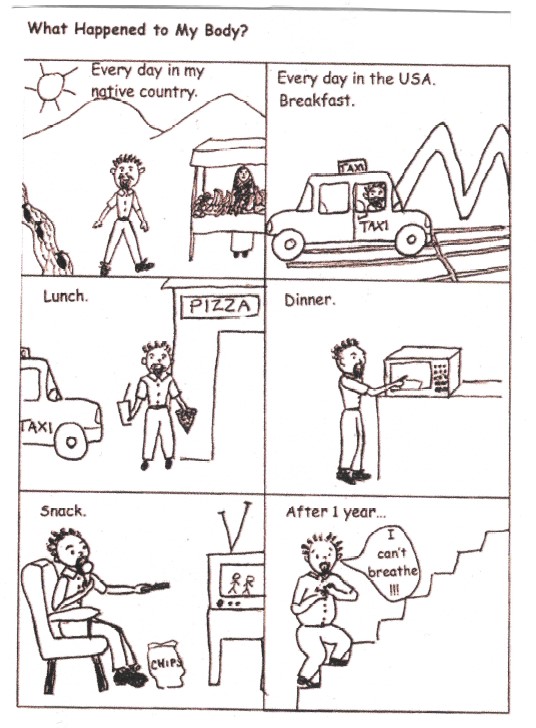
This picture story might not be suitable for every test-taker. “My native country” vs “the USA” probably refers to new immigrants to the United States and the changes to diet and lifestyle they undergo in their new country. The context might be unclear to those test-takers who cannot relate to this particular situation, while the pictures themselves leave a lot to be inferred.
Another problem with the task is that it requires a narration in the first person (“What happened to my body?”). Obesity might be a sensitive topic to many test-takers who would not wish to identify with the problem, so it would be advisable to ask for a third-person narration instead (e.g., “What happened to John’s body?”).
Recommendations for producing description tasks
- – This task type can be used in computer-mediated, computer-based, and in face-to-face tests, both through individual and paired formats.
- – Pictures are normally used in this task type: test-takers can be given one picture to describe or two/several pictures to compare and contrast.
- – Pictures that contain people normally generate more language than landscapes or still life. Make sure the pictures are clear and not crowded or out of focus.
- – Pictures are often culturally specific. When selecting pictures, make sure your test-takers are familiar with the situations presented in the picture (e.g., it might be unfair to ask test-takers from an equatorial country to describe a ski resort).
- – For picture comparison tasks, select pictures that have enough grounds for comparison but, at the same time, are not too similar. Trialling the pictures with several students normally helps to uncover potential problems.

This picture is very abstract – it might result in extremely varied responses which would be difficult to mark. Moreover, the ability to interpret the picture will depend on the test-takers’ background knowledge, while it is not something we should be assessing in a language test. In a picture description task, it is advisable to use images containing only literal meaning.

This picture comparison task might not generate a lot of rateable language because the pictures are too similar. Another reason is that both pictures present a landscape without people in it – such pictures normally generate less discourse. It is also advisable to use colour images for speaking tasks. In this task, test-takers would have to imagine the colours to describe the pictures, as a result, test-takers with a more developed imagination (which is not something we aim to assess in a language test) will perform better.
Recommendations for producing instruction tasks
- – This task type does not suit computer-based tests because some interaction between the speaker and the listener (who can be the examiner or another test-taker) is required.
- – Instruction tasks are often map-based: test-takers are required to give directions based on a map.
- – Map reading can be culturally specific – make sure the style of the map (layout, legend, labels) is familiar to your test-takers.
- – Map reading is not suitable for younger learners.
- – Make sure the map is not confusing, has a clear layout, and isn’t crowded with information. Trial the task with several students before using it in a live test.

This map is very crowded – it might confuse test-takers. It would also be extremely difficult to give directions based on this map.
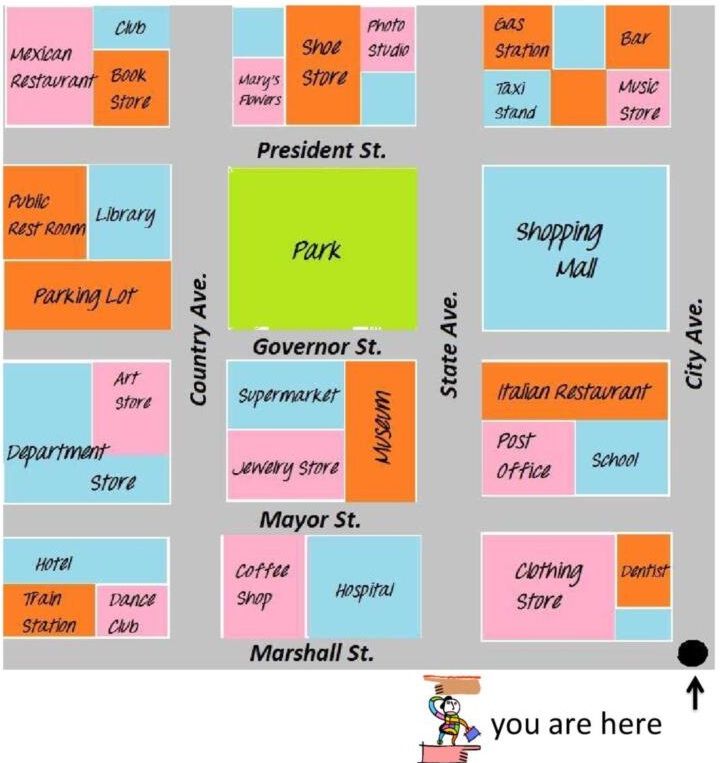
This map, although very simple and clear, is also quite unlike maps one would encounter in real life. If you would like to use a map like this in a test, get your students acquainted with this map style in the lessons.
Recommendations for producing graph/chart/table-based tasks
- – This task type is suitable for computer-delivered tests. However, it can also elicit interaction if a pair or a group of test-takers are asked to speculate about the information or discuss its implications.
- – This task type works well in eliciting explanations (explaining the information presented in the visual stimulus) as well as speculations (why the trend has arisen, what might the implications be), and predictions (what might happen in the future as a result of the trend).
- – This task type might require reasoning ability, which is unrelated to speaking ability. To reduce the cognitive load, make sure the visuals are not too complex and don’t require specialist knowledge (unless the task is used in an academic or specific-purpose test).
- – Graphs/charts can be culturally specific. Make sure the style of the chart/graph (layout, legend, labels) is familiar to your test-takers.
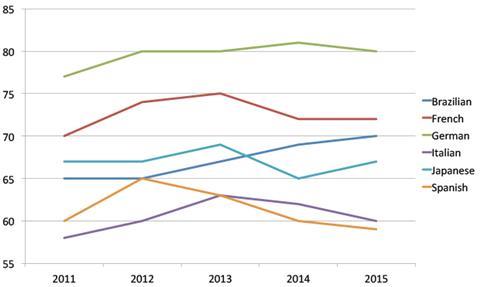
This line graph looks crowded; also, because the colours are quite similar, it might be difficult for test-takers to match the legend to the right line. Moreover, the legend is vague: it is unclear what “Brazilian”, “French” etc. refer to, and what the numbers on the vertical axis represent. Graphs/charts should be self-explanatory; it should not be necessary for the examiner to explain what the visual is about.
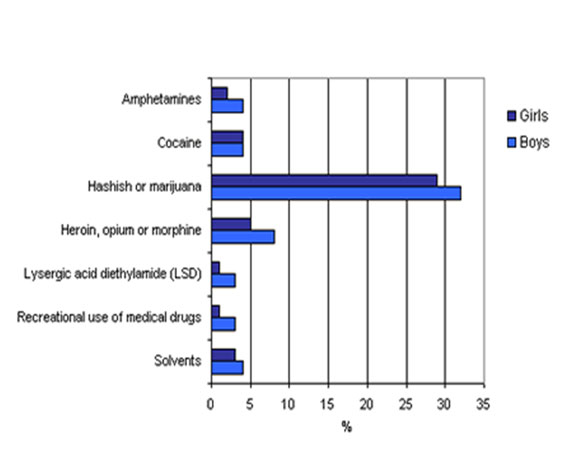
The topic (drug use) is unsuitable for a test. The chart also seems to suggest that drugs are commonly used by young people, which is not necessarily true and which is not a helpful idea to promote.
Recommendations for producing presentation tasks
- – This task type can be used in computer-mediated, computer-based, and face-to-face tests. In face-to-face tests, it is most suitable for individual (one test-taker) format.
- – Presentation tasks help elicit extended discourse. They are often used in academic or specific-purpose tests; this task type might be unsuitable for young learners, unless they are allowed to prepare a presentation beforehand.
- – Care should be taken in selecting suitable topics for presentations: topics should be interesting enough to motivate test-takers to talk, the topics should also be familiar enough to make sure test-takers have sufficient ideas to produce a speech of the stipulated length.
- – Task instructions should include a suggestion regarding desired test-taker speech length. This requirement should be realistic: trial the task with several students to determine how long a speech a particular prompt can realistically elicit.
- – Several bullet points can be included in the topic card to suggest ideas for test-takers to talk about. Avoid using full sentences which can then be re-used by test-takes in their speech: the bullet points should be informative but very brief.
- – Allow some preparation time for test-takers to plan their presentation.
- – During the preparation time, test-takers might be allowed to write down their ideas. Make sure the preparation time is not too long so that test-takers aren’t able to write down the whole speech and then read it out. The optimal preparation time should be established during task trials.
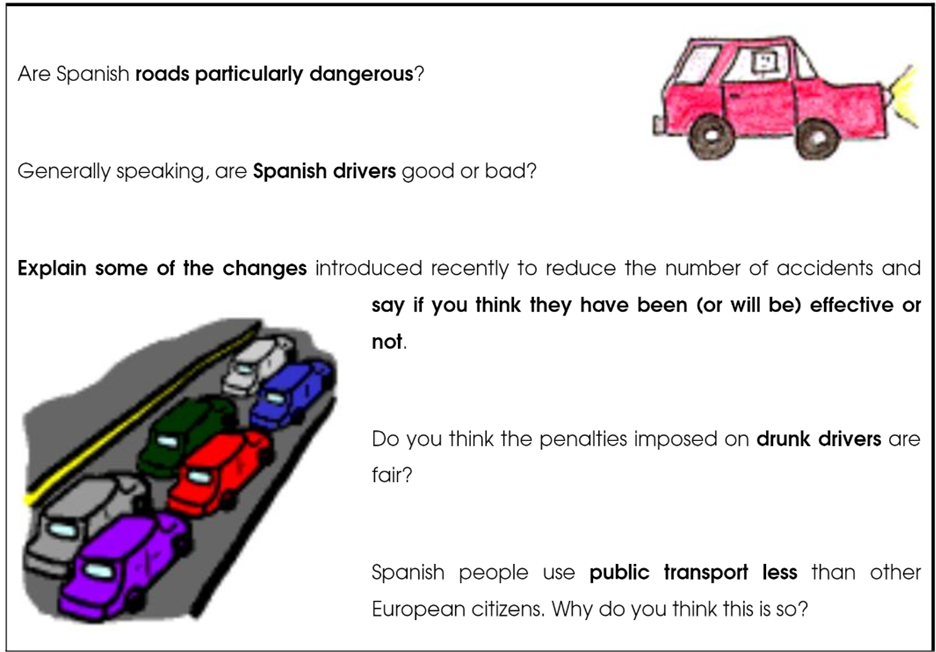
This task comes from a test for Spanish learners of English. The test seems to assume that all test-takers will be familiar with some country-specific information such as “changes introduced recently to reduce the number of accidents” or “penalties imposed on drunk drivers”. However, not all test-takers will know this information so those who do might have an unfair advantage.
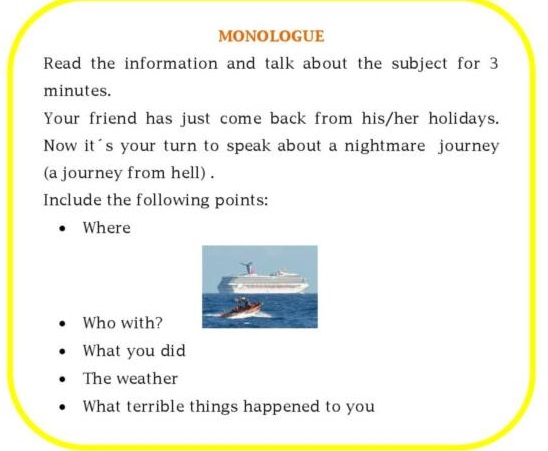
The task format is confusing: the task is a “monologue”, as suggested by the title, so it is unclear what role a friend (“your friend has just come back from his/her holidays”) plays in setting the situation.
Talking about “a journey from hell” might not be a suitable topic for a test; it would be more advisable to ask about a successful holiday instead.
A picture included in the instructions might be confusing to some test-takers who might take it too literally as a suggestion to talk about cruise holidays only. Overall, it is not advisable to include pictures in test tasks that only serve a decorative purpose.
Recommendations for producing discussion tasks
- – Discussion tasks are more suitable for face-to-face testing.
- – This task type works best in paired/group test formats. Individual test format – when the discussion happens between a test-taker and the examiner – is also possible, although the power imbalance might limit the test-taker’s ability to disagree with the examiner and to express opposing views.
- – Discussions that involve making a decision (e.g., selecting the best candidate for a job from a list of applicants) tend to generate more talk.
- – Make sure the topic is within the test-takers’ experience for them to have something to say. The topic should also be age appropriate.
- – A role play is a type of discussion task; role cards specifying the situation and individual character roles are assigned to test-takers. Role plays might be challenging for some test-takers who might feel it difficult to assume a role because it is not natural for them (e.g. a shop assistant as in a shopping situation) or because they feel they are not good at acting.
| Pair discussion task: Is there life after death? |
This topic is not suitable as a test task; it might not be suitable as a classroom activity, either. The topic involves religious beliefs which some test-takers might feel very strongly about. For many others, the topic will be upsetting and might trigger an anxious emotional reaction that will not allow the test-takers to do their best in the test.

The instructions to this task asked test takers to “discuss the names for the activities”. Although the pictures themselves make a meaningful set, a “discussing the names” task is not meaningful and will result in test-takers naming the activities in the pictures one by one using single words / phrases; such a task will take about 10 seconds to complete. Moreover, the names of the activities are not controversial so don’t give much ground for discussion. It would be more meaningful to ask test-takers, for example, to discuss the importance of the activities for one’s health. Better still, the test-takers can be instructed to arrange the activities in order from least to most beneficial – this involves decision-making, a process which tends to generate more talk.
| Role play task: Student 1: You think being a vegetarian is a good idea. Have at least three reasons to support your opinion. Student 2: You think being a vegetarian is a bad idea. Have at least three reasons to support your opinion. |
A test-taker who is a vegetarian will find it difficult to assume the Student 2 role. Asking the test-takers which role they prefer will not work because both might be either vegetarians or meat-eaters. Moreover, allowing a choice will disadvantage the test-taker who might not receive the role they want. Additionally, vegetarianism is a topic many people feel strongly about nowadays, so discussing it (especially while assuming an undesired or false role) might provoke strong emotional reactions that will not allow the test-taker to do their best during the test.
Further reading
Brown, G., & Yule, G. (1983). Teaching the spoken language. Cambridge University Press.
Fulcher, G. (2003). Testing second language speaking. Taylor & Francis Group.
De Jong, N. H. (2023). Assessing second language speaking proficiency. Annual Review of Linguistics 9, 541-560. https://doi.org/10.1146/annurev-linguistics-030521-052114
Luoma, S. (2004). Assessing speaking. Cambridge University Press.

